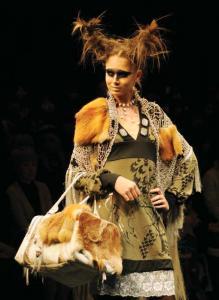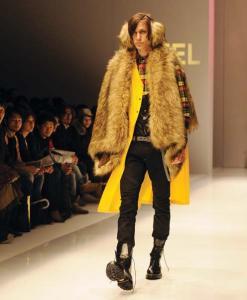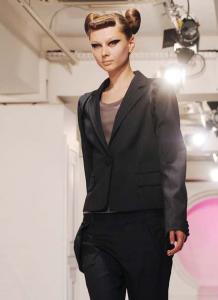Lacking in Style
By Timothy Coghlan
Tim Coghlan reviews Japan Fashion Week and ponders its failure to establish Tokyo on a par with Paris or Milan.
Japan Fashion Week (JFW) in Tokyo was held from March 10-15 in various locations around Tokyo. After attending a fair portion of the 50 fashion shows held during JFW it was clear that it has a long way to go before it becomes truly international and part of the world fashion week circuit which is dominated by cities like Paris, Milan and New York. JFW—the country’s ‘official’ fashion week, has been attempting to gather momentum since it started in 2005. Yet, despite Tokyo being the fashion capital of Asia and certain Japanese brands being very popular overseas, JFW has been struggling to gain international attention for several reasons.
 Click on image for enlargement.
Click on image for enlargement.
Firstly, the event has not been well orchestrated in the past with the fashion shows being held in out-of-the-way places including Jingumae and building foyers around Tokyo station. During fashion week there can be up to ten shows on any given day and for international press and buyers to make it to as many shows as possible, the venues need to be accessible and easy to find for non-Japanese speakers. The organizers are aware of this and have endeavored to improve the situation by centering the event around Tokyo Midtown, but with only two halls available for shows there is clearly a need for further improvement.
 Click on image for enlargement.
Click on image for enlargement.
Another problem for JFW has been getting the right message across. Fashion must be seen as cutting edge, chic and having aesthetic appeal. Unfortunately, JWF is caught in a catch-22 situation. As JFW is still in its infancy and not yet able to support itself, it requires a great deal of financial support from the Japanese government and other big sponsors such as Uniqlo and Isetan. But government support and mass-market low-cost brands like Uniqlo have the effect of making JFW seem bureaucratic and dowdy rather than chic and cool. For this reason, some Japanese designers, such as Daisuke Obana from the brand N.Hollywood, are choosing to stage their fashion shows during fashion week when everyone is in town, but at the same time actively choosing not to be associated with the official JFW proceedings. Furthermore, all self-respecting fashion designers dream of showing their collections at either the Paris or New York fashion weeks and therefore, for Japanese designers who do make it big, it isn’t long before they inevitably shun JFW in favor of showing overseas.
 Click on image for enlargement.
Click on image for enlargement.
In this respect, JFW is proving somewhat effective as a launching pad for sending Japanese designers overseas, but it isn’t doing particularly well in luring foreign interest and fashion dollars to Japan. Even the official name of ‘Japan Fashion Week in Tokyo’ doesn’t sound as chic as its counterparts in Paris and Milan. Just as people would scoff at an ‘American Fashion Week’ instead of ‘New York Fashion Week,’ Japan’s title doesn’t have the same allure or class as the name ‘Tokyo Fashion Week.’ Once again, it’s all about creating an image. Moreover, after the other world fashion weeks, many international fashionistas are simply worn out and too tired or busy to be willing to travel to Tokyo for a week of relatively unknown designers.
To attract more foreign interest in JFW, organizers need to encourage internationally known Japanese brands to be part of the event. However, the Japanese fashion brands that have made it big overseas in recent years have mostly been street fashion brands such as Hysteric Glamour and A Bathing Ape—brands which traditionally aren’t involved in ‘sophisticated’ fashion weeks. Although not officially part of JFW, the biggest show of fashion week was Tokyo Girls Collection (covered in J@pan Inc No 73), which has acquired international attention by creating a female fashion festival based around the concept of ‘Japanese Real Clothes for the World’ instead of the usual luxury, high-end brands.
Overall, Japan Fashion Week is in the difficult position of wanting to be part of the international fashion week circuit, but not quite knowing how to get there. Despite the above-mentioned flaws, at least Japan is trying. You have to be in it to win it!
Timothy is a freelance style and design writer and can be contacted at timkyo@gmail.com






